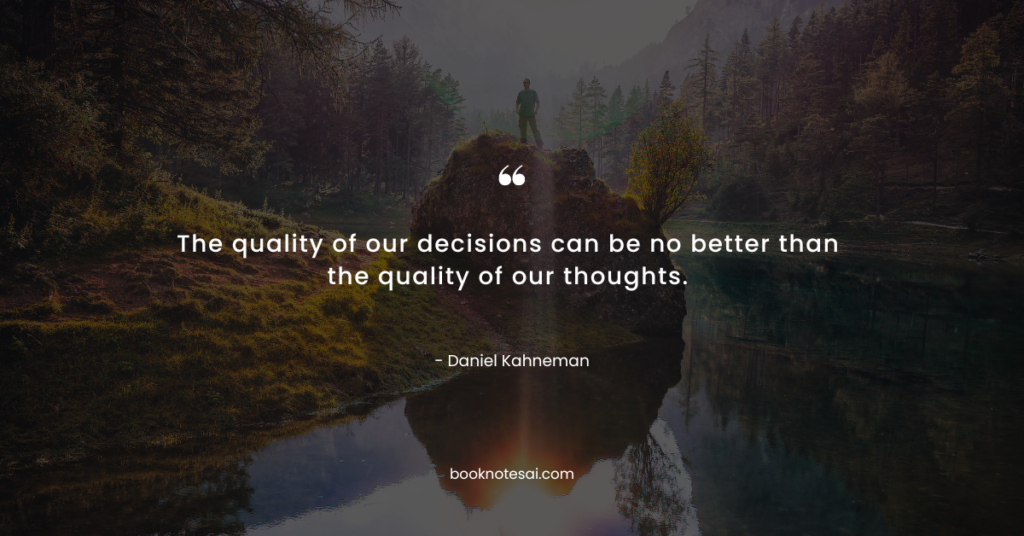Listen To This Post
Unleashing the Two Systems That Shape Our Thinking

This is a book summary for Thinking, Fast and Slow by Daniel Kahneman. The key facts are organized to be easy to use, clear, and very valuable, all while helping you save loads of time.
Introduction: Why this book?
- Dive into the intriguing realm of cognitive psychology with Daniel Kahneman’s groundbreaking work that elucidates the intricate interplay between our intuitive and rational minds.
- Through vivid examples and compelling research, Kahneman unveils the hidden biases and heuristics that influence our decision-making processes, offering invaluable insights into human behavior and judgment.
Thinking, Fast and Slow Summary:
- Daniel Kahneman, a Nobel laureate in Economics, explores the dichotomy of human thinking through the lens of two systems: System 1, intuitive and automatic, and System 2, deliberate and analytical.
- The book delves into various cognitive biases, such as the availability heuristic and the framing effect, shedding light on how these mental shortcuts can lead to errors in judgment and decision-making.
- Kahneman elucidates the concept of prospect theory, challenging traditional economic models by highlighting the role of loss aversion and reference points in shaping our preferences and behaviors.
- Through engaging anecdotes and thought-provoking experiments, the author illustrates the limitations of human rationality and the pervasive influence of intuition in our everyday lives.
- Ultimately, Thinking, Fast and Slow serves as a compelling manifesto for understanding the intricacies of the human mind and making better decisions in an uncertain world.
 5 Big Ideas
5 Big Ideas
- The Two Systems of Thinking: Kahneman delineates between System 1, the fast, instinctive mode, and System 2, the slower, more deliberate mode, providing insights into how they operate and interact.
- The Influence of Heuristics: By exploring cognitive biases like anchoring and confirmation bias, Kahneman reveals how these mental shortcuts can distort our perception of reality and lead to systematic errors in judgment.
- Prospect Theory and Loss Aversion: Through prospect theory, Kahneman challenges the traditional economic notion of rational actors by demonstrating the asymmetrical impact of gains and losses on decision-making.
- The Power of Framing: Kahneman underscores the importance of how information is presented, showing how framing can significantly influence decision outcomes and perceptions.
- Strategies for Better Decision Making: Drawing on research and practical insights, Kahneman offers strategies to mitigate cognitive biases and improve decision-making, emphasizing the value of mindfulness and deliberate thinking.
In summary, Kahneman illuminates the complexities of human cognition and decision-making, offering practical wisdom for navigating the intricacies of our minds and the world around us.
Powerful Quotes
- “The illusion that we understand the past fosters overconfidence in our ability to predict the future.”
This quote highlights the tendency to overestimate our predictive abilities based on incomplete or flawed information. - “Our comforting conviction that the world makes sense rests on a secure foundation: our almost unlimited ability to ignore our ignorance.”
This quote emphasizes our propensity to overlook our own ignorance and the limitations of our knowledge. - “Nothing in life is as important as you think it is, while you are thinking about it.”
This quote underscores the transient nature of attention and the fleeting significance we attribute to current concerns. - “We can be blind to the obvious, and we are also blind to our blindness.”
This quote elucidates the phenomenon of meta-ignorance, wherein we remain unaware of the extent of our own ignorance. - “A reliable way to make people believe in falsehoods is frequent repetition because familiarity is not easily distinguished from truth.”
This quote highlights the power of repetition in shaping beliefs and perceptions, irrespective of their factual accuracy. - “The idea that the future is unpredictable is undermined every day by the ease with which the past is explained.”
This quote exposes the fallacy of hindsight bias, wherein events appear predictable in retrospect, despite their inherent uncertainty. - “The main function of System 1 is to maintain and update a model of your personal world, which represents what is normal in it.”
This quote elucidates the role of System 1 in constructing and perpetuating our subjective reality. - “Laziness is built deep into our nature.”
This quote acknowledges the cognitive biases and mental shortcuts that underlie human decision-making, often driven by the path of least resistance. - “The quality of our decisions can be no better than the quality of our thoughts.”
This quote underscores the importance of critical thinking and deliberate reflection in enhancing decision-making effectiveness. - “We are prone to overestimate how much we understand about the world and to underestimate the role of chance in events.”
This quote highlights our tendency to succumb to the illusion of understanding and control, neglecting the role of randomness and chance in shaping outcomes.
One Reason To Read This Book:
Explore the fascinating realm of human cognition and decision-making through the lens of Nobel laureate Daniel Kahneman’s seminal work, gaining invaluable insights into the intricacies of the mind and the art of effective decision-making.
Who should I recommend Thinking, Fast and Slow Summary to?
This summary is ideal for curious minds of all ages and backgrounds seeking to unravel the mysteries of human thought and behavior.
The professionals in fields like psychology, economics, and decision sciences will find particular value in its profound insights and practical applications.
Recommendations:
- “Predictably Irrational” by Dan Ariely: Explores the irrational tendencies that influence human decision-making.
- “Nudge” by Richard H. Thaler and Cass R. Sunstein: Offers strategies for designing environments that encourage better decision-making.
This summary serves as a complimentary guide to the reviewed title Thinking, Fast and Slow, offering key insights. For a deeper understanding, we encourage you to explore the full book.


